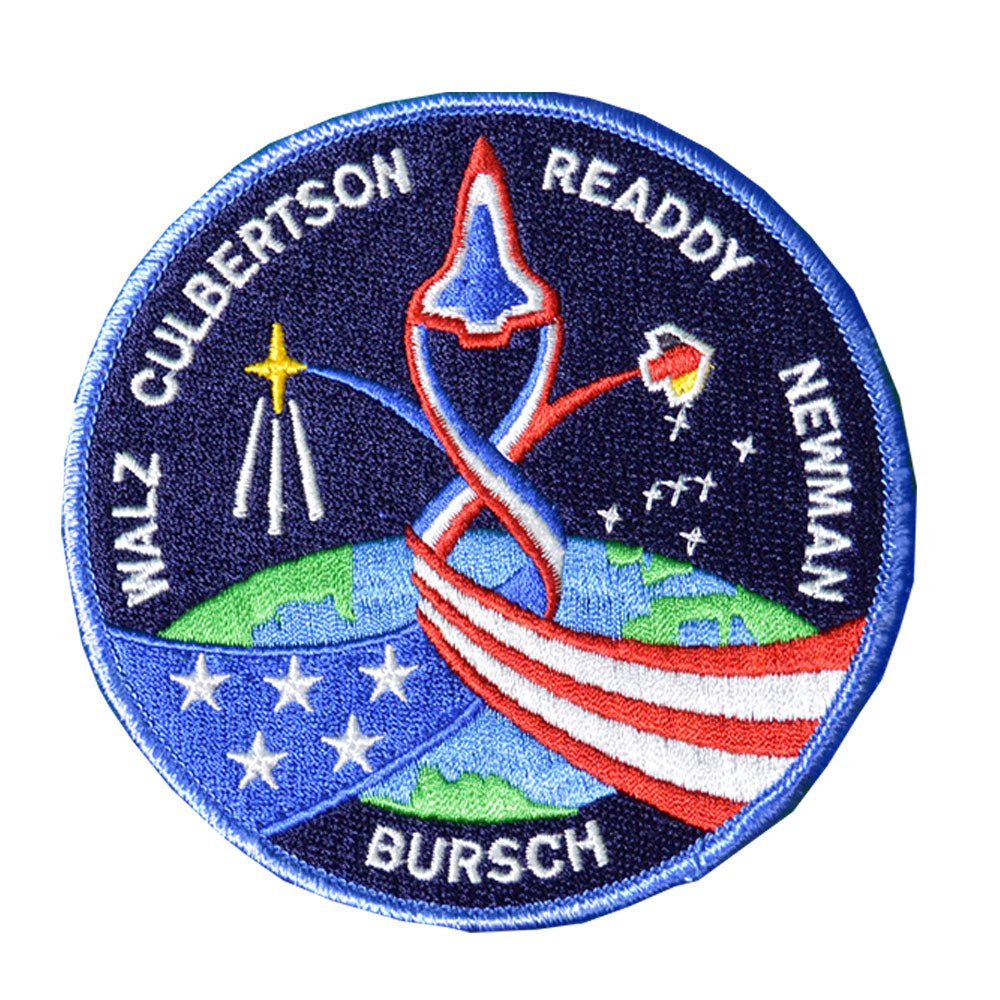
STS-51 Patch
STS-51 Patch
Launch Highlights
Officials decided to scrub Discovery’s mission Saturday, July 17, at about 8:52 a.m. EDT because all eight of the solid rocket booster hold down bolts and the T-0 liquid hydrogen vent arm, located on the side of the external tank, were prematurely charged with current. This charge is normally initiated at the T-18 second mark in the countdown. The problem circuit card in the pyrotechnic initiator controller (PIC) which caused the launch scrub on Saturday has been replaced on the mobile launcher platform. Efforts to duplicate the problem on the suspect card were successful at KSC’s malfunction laboratory. A thermally unstable circuit was the culprit. The problem was narrowed down to a prematurely charged capacitor in the firing circuit of all eight solid rocket booster hold down posts and the T-0 liquid hydrogen vent arm, located on the side of the external tank.
Launch was delayed on Saturday, July 24, due to a problem with the right hand solid rocket booster (SRB). The ground launch sequencer detected an unacceptably slow speed rate of a hydraulic power unit located inside the shuttle’s right hand solid rocket booster. The hydraulic power unit (HPU) was replaced and retested.
Launch was again delayed until 9:10 a.m. EDT on August 12 due to concerns about the Perseid meteor shower which is expected to peak on the evening of August 11. The Perseid event, which happens each August, is one of about a dozen such occasions each year that are the result of a comet’s nucleus shedding debris along its orbital path as it approaches the Sun. When Earth’s orbit passes through the debris field it causes meteor showers activity or “shooting stars.” The concern with the Perseid event was that the activity is expected to be extremely heavy this year and thus there was an increased chance that a spacecraft in Earth orbit could be damaged by a piece of the debris.
Launch on August 12 was scrubbed at the T-3 second mark following a redundant set launch sequencer (RSLS) abort. The cause for the RSLS abort was a faulty sensor that monitors fuel flow through main engine #2. Engine cutoff occurred at 9:12:32 a.m. EDT. There are two sensors which are part of the flow meter that monitor the flow of hydrogen through the main engine. Each sensor has a Channel A and Channel B for a total of four readings. These sensors are monitoring the fuel flow from main engine ignition through main engine cutoff.
The sensors are redundant so that all four channels must report an acceptable fuel flow rate prior to liftoff. Data indicates that Channel A on the number two sensor failed. There was no electrical output at all from this sensor while the others were found to have operated normally. A completely redundant set of measurements is required to commit to flight. All three of Discovery’s main engines were removed and replaced with a set from Endeavour at the Pad. Tests conducted under cryogenic conditions were successful in duplicating the sensor failure that caused the launch scrub.
On September 9, the pickup of the launch count was delayed pending the outcome of the ACTS Independent Review Team. This team met to review the design of the ACTS spacecraft in light of the recent loss of contact with the Mars Observer spacecraft and the failure of the NOAA-13 weather satellite. All three spacecraft are manufactured by Martin Marietta. TOS contains two transistors manufactured in the same manner as those made by Unitrode that are suspected in the failure of Mars Observer.
Mission Highlights
One of two primary payloads, Advanced Communications Technology Satellite (ACTS), deployed on flight day one. About 45 minutes after ACTS deploy, attached Transfer Orbit Stage (TOS) booster – flying on the shuttle for the first time – fired to propel pioneering communications technology spacecraft to geosynchronous transfer orbit.
On flight day two, crew deployed second primary payload, Orbiting and Retrievable Far and Extreme Ultraviolet Spectrograph-Shuttle Pallet Satellite (OERFEUS- SPAS), first in series of ASTRO-SPAS astronomical missions. Extensive footage of orbiter recorded by IMAX camera mounted on SPAS. Joint German-U.S. astrophysics payload was controlled via SPAS Payload Operations Control Center (SPOC) at KSC, becoming first shuttle payload to be managed from Florida. After six days of data collection, ORFEUS-SPAS retrieved with remote manipulator system arm and returned to cargo bay.
On Sept. 16, Mission Specialists Newman and Walz performed extravehicular activity (EVA) lasting seven hours, five minutes and 28 seconds. Final in series of generic space walks begun earlier in year. Astronauts also evaluated tools, tethers and foot restraint platform intended for the upcoming Hubble Space Telescope servicing mission.
Other cargo bay payloads: Limited Duration Space Environment Candidate Material Exposure (LDCE). Middeck payloads: IMAX 70 mm camera; Commercial Protein Crystal Growth (CPCG) Block II; Chromosome and Plant Cell Division in Space (CHROMEX-04); High Resolution Shuttle Glow Spectroscopy (HRSGS-A); Aurora Photography Experiment (APE- B); Investigation into Polymer Membranes Processing (IPMP); and Radiation Monitoring Equipment III (RME III); Air Force Maui Optical Site (AMOS) calibration test also performed.


